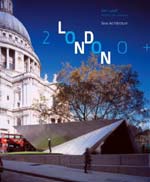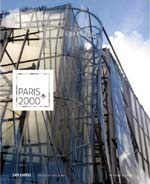
|

|
|
Home Site Search Contact Us Subscribe
|
|
|
Book Review: Tripping Out to London and Paris Time to become a homebody, shop frugally, eat in, and take a virtual tour led by Sam Lubell By Sam Hall Kaplan April 8, 2009 With airfares descending to the reasonable, especially for those who monitor travel sites, dollar-to-whatever exchange rates the most favorable in years, and select hotels willing to bargain, it would seem a good time for architecture aficionados to travel abroad. There is nothing like experiencing the latest designs and persevering landmarks within their context and culture, especially when the weather is agreeable. (And I am reminded by my tax accountant that such travel for those in the design and development field can be deductible.)
The problem, of course, is that architecture and its allied arts, crafts, and construction trades are experiencing a disastrous downturn in the current economy. Having an income, however modest, to splurge on travel has become an increasingly rare discretion as jobs, salaries, and opportunities plummet. Even principals high on the pecking order are feeling the pinch. Time to become a homebody, shop frugally, eat in, and curl up with a good book and go on a virtual tour. True, books however well written and illustrated cannot substitute for the real encounter with a distinctive space or place, but they can be transcendental. And, yes, such books also can be a deduction.
For those who haven’t been to London recently, Sam Lubell offers a discerning tour of what is relatively new and interesting in London 2000+: New Architecture (Monacelli Press, 2008). This includes the obvious standouts and stand alones bidding for icon status: Foster + Partners’ soaring tapered office tower, the so-called “Gherkin,” Marks Barfield’s reengineered Ferris wheel known as “The Eye,” Daniel Libeskind’s Metropolitan University addition (typically geometrically challenged), Herzog & de Meuron’s contrasting demure Laban Dance Centre, and my favorite, Rogers Stirk Harbour + Partners’ striking, sustainable Lloyd Register. These design conceits alone have transformed the here-to-fore London skyline from the century old cliché of Mary Poppins chimney roosts to a Babel of buildings benefiting the city’s status as one of the world’s foremost financial capitals.
Also included on Lubell’s tour, aided by a finical compilation of studied photographs offering a variety of pristine perspectives, are a selection of more modest additions to the London cityscape: the adaptive reuse of a railway shed into a performance center by John McAslan +Partners, a dance studio addition by Sarah Wigglesworth, a children’s center by Deborah Saunt and David Hills Architects, and an engaging range of residential projects from single family to multi-use. Set in very urban to suburban London, all display a respect for the varied users, an awareness of context, and an imagination of materials. Their inclusion also displays of the author’s very welcome sensitivity to the recent shifts in design in London on a very human scale as the city of old accommodates a city of the new. Lending a perspective to this transition is a foreword by Ken Livingstone, who was the mayor of London from 2000 to 2008, proudly championing a city “inspired by its history without being burdened by it.”
Since I enjoyed Lubell’s illustrated tour of London, I thought I’d check out his earlier book on Paris, published last year, and written with the same modern sensibilities, Paris 2000+: New Architecture (Monacelli Press, 2007). Here, arguably, is a city with the richest architectural history in the world that, though not a power center such as London or New York, still considers itself the epitome of design, be it architectural and urban, as well as food, fashion, and art. This apparently is a burden as well as a blessing. As Axel Sowa, the editor of L’Architecture d Aujourd’hui, comments in a surprisingly sharp preface, the city’s “legendary beauty makes it one of the most challenging places to build.” He explains that the city’s dense urban fabric leaves little room for new architecture, while its equally dense bureaucracy and conservative citizenry tend to cast a cautious eye on change. Here is a city “foundering in a delirium brought on by its own cultural heritage,” declares Sowa.
Yet as Lubell has assembled here in this inspired survey, architectural innovations persevere, and since 2000 a number of distinctive structures have emerged. “Like much contemporary work internationally, their design is driven by intense site-specific research and by individual vision, not by any regional spirit or prevailing dogma,” observes Lubell. Included among the 30 select projects of note are Jean Nouvel’s brash, bold Musée du Quai Branly, and Christian de Portzamparc’s Le Monde Headquarters, its façade clad with a giant replica of the front page of the paper, replete with a cartoon. As an old print person, you have to love it. Provocative also is Los Angeles-based architect Michele Saee’s renovation of a landmark drugstore. More prosaic is AREP’s train station. There is also a selection of other structures that may not reflect our image of Paris on first glance, but still engages one urbanistically and demands an awareness of the city's placemaking traditions. What more can one ask from an architecture book.
Actually, the effect of reading Lubell’s tour of Paris, as well as of London, is not to satisfy a yearning to travel in lieu of diminished discretionary income, but be inspired to somehow find the funds to travel, with, of course, Lubell as a guide.
Sam Hall Kaplan is a Los Angeles based urban planner and designer who has pursued a parallel career as a best selling author (LA Lost & Found: An Architectural History of Los Angeles), an Emmy Award winning commentator, and a caustic architecture critic, for the LA Times among others. He is at present a contributor to The Architect’s Newspaper and local NPR station KPCC, while in the real world he perseveres as an independent consultant to the Kosmont real estate services firm aiding ailing cities and distressed development corporations. He can be reached at hallkaplan@earthlink.net.
|
(click on pictures to enlarge) 

|
© 2009 ArchNewsNow.com